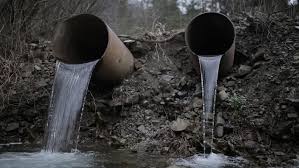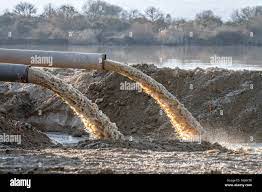Liquid wastes refers to any form of waste that is in a liquid state, such as wastewater or liquid byproducts generated from various industrial, commercial, and domestic activities.
It typically includes substances that are predominantly liquid, although it may contain some solid materials suspended or dissolved within the liquid. Liquid waste can be categorized into different types based on its composition and source.
Here are a few common examples of liquid waste:
Domestic wastewater: This includes the water discharged from households, such as kitchen sink water, bathroom wastewater (from toilets, showers, and sinks), and laundry water.
Industrial wastewater: Industries produce liquid waste during manufacturing processes. This can include various chemicals, solvents, heavy metals, oils, and other pollutants that are present in the wastewater generated by factories, power plants, refineries, and other industrial facilities.
Medical waste: Liquid waste generated by healthcare facilities, such as hospitals, clinics, and laboratories, includes items like used syringes, medical solutions, blood, bodily fluids, and pathological waste.
Agricultural waste: Farming activities can generate liquid waste in the form of fertilizers, pesticides, herbicides, and animal waste runoff, which may contain pollutants like nitrogen, phosphorus, and organic matter.
Hazardous waste: Certain liquid waste is considered hazardous due to its toxic, flammable, corrosive, or reactive properties. This can include chemicals, solvents, acids, heavy metals, and other industrial byproducts.
Proper management and treatment of liquid waste are crucial to minimize its impact on the environment and human health. Many wastewater treatment facilities are designed to treat and remove pollutants from liquid waste before it is discharged into water bodies or recycled for various purposes.
Products That Can Be Derived From Liquid Wastes

Liquid wastes can be processed and transformed into various useful products through different methods. Here are some examples:
1. Biogas
Liquid organic wastes, such as sewage, animal manure, and food waste, can undergo anaerobic digestion to produce biogas. Biogas is a mixture of methane and carbon dioxide, which can be used as a renewable energy source for heating, electricity generation, and cooking.
2. Fertilizers
Liquid wastes rich in nutrients, such as sewage sludge or effluents from agricultural or food processing industries, can be treated and processed to produce organic fertilizers. These fertilizers can provide essential nutrients for plant growth and help improve soil fertility.
3. Biofuels
Certain liquid wastes, including used cooking oil, grease, and agricultural residues, can be converted into biofuels through processes like transesterification or hydrothermal liquefaction. These biofuels, such as biodiesel and bio-oil, can be used as alternative sources of energy in transportation and industrial applications.
4. Industrial chemicals
Some liquid wastes contain valuable chemicals that can be extracted and used in various industries. For example, wastewater from paper mills or textile dyeing facilities may contain dyes or pigments that can be recovered and reused.
5. Clean water
Advanced treatment technologies can purify and remove contaminants from liquid wastes, transforming them into clean water suitable for reuse. This process, known as wastewater treatment, involves multiple steps like filtration, biological treatment, and disinfection to produce treated effluent that can be used for irrigation or discharged back into water bodies.
6. Nutraceuticals and pharmaceuticals
Liquid wastes generated from pharmaceutical manufacturing or biotechnology processes can contain valuable compounds that can be extracted and used in the production of nutraceuticals or pharmaceuticals. These compounds may have medicinal or therapeutic properties.
7. Construction materials
Liquid wastes, such as fly ash from coal-fired power plants or slag from metal smelting processes, can be processed and incorporated into building materials like cement or concrete. This reduces the environmental impact of waste disposal and conserves natural resources.
8. Animal feed
Liquid agricultural wastes, such as dairy or brewery effluents, can be treated and processed to produce animal feed. The nutrients in these wastes can be utilized to create feed supplements for livestock, reducing the need for conventional feed sources.
It’s worth noting that the suitability and feasibility of deriving specific products from liquid wastes depend on various factors, including the composition of the waste, available technologies, and local regulations.
Read Also: Understanding and Challenging Stereotyped Motor Behaviors
9. Bio-based chemicals
Liquid wastes generated from the processing of crops, such as corn or sugarcane, can be utilized to produce bio-based chemicals. These chemicals can serve as alternatives to petroleum-based chemicals in industries like plastics, cosmetics, and pharmaceuticals, reducing dependence on fossil fuels and lowering environmental impact.
10. Aquaculture feed
Liquid wastes from fish processing plants or aquaculture facilities can be treated and processed to create feed for fish and other aquatic organisms. The waste products can be transformed into nutrient-rich feed pellets, reducing the need for wild fish as a food source in aquaculture operations.
11. Soil amendments
Liquid wastes that undergo appropriate treatment processes can be converted into soil amendments. These amendments, such as compost or organic matter, can enhance soil quality, improve water retention, and promote plant growth. They can be particularly beneficial for agricultural and horticultural applications.
12. Bio-based plastics
Certain liquid wastes, such as vegetable oils or organic residues, can be used as feedstocks for the production of bio-based plastics. These plastics offer an eco-friendly alternative to traditional petroleum-based plastics and can be utilized in various industries, including packaging, automotive, and consumer goods.
13. Industrial water
Liquid wastes generated in industrial processes, after undergoing proper treatment, can be transformed into industrial water suitable for specific applications. For example, wastewater from manufacturing operations can be treated and recycled for cooling systems or other non-potable water needs within the industry.
14. Clean energy storage
Liquid wastes can be processed to extract valuable chemicals like hydrogen, which can be used as an energy carrier in fuel cells or other energy storage technologies. This contributes to the development of sustainable and renewable energy systems.
15. Bio-based materials
Liquid wastes, such as agricultural residues or food processing byproducts, can be processed and converted into bio-based materials. These materials can be used for various purposes, including biodegradable packaging, insulation, or construction materials, reducing reliance on non-renewable resources.
15. Bioethanol
Liquid wastes containing high levels of fermentable sugars, such as agricultural residues or food processing byproducts, can be used as feedstocks for the production of bioethanol. Bioethanol is a renewable fuel that can be blended with gasoline or used as a standalone fuel in transportation.
16. Cleaning and hygiene products
Liquid wastes, particularly those from personal care product manufacturing or cleaning processes, can contain chemicals that can be extracted and used in the production of cleaning agents, detergents, soaps, and other hygiene products.
Read Also: The Neal Recycling Initiative
17. Organic acids
Liquid wastes from certain industries, such as food processing or fermentation processes, can be processed to extract organic acids. These acids, such as citric acid or lactic acid, have various applications in the food and beverage industry, pharmaceuticals, and other sectors.
18. Bio-based paints and coatings
Liquid wastes derived from agricultural crops or bio-based feedstocks can be transformed into bio-based paints and coatings. These environmentally friendly alternatives to conventional paints offer lower VOC (volatile organic compound) emissions and reduced environmental impact.
19. Renewable fibers
Liquid wastes containing natural fibers, such as wastewater from textile or paper manufacturing, can be processed to recover and recycle those fibers. The fibers can then be used to produce textiles, paper products, or even innovative materials like biodegradable packaging.
20. Microbial products
Some liquid wastes can serve as a nutrient-rich medium for the growth of specific microorganisms. These microorganisms can produce valuable products such as enzymes, enzymes, biopolymers, or even probiotics, which have applications in various industries, including food, pharmaceuticals, and biotechnology.
21. Nutrient-rich supplements
Liquid wastes from food processing or agricultural operations can be processed to extract nutrients like vitamins, minerals, or proteins. These nutrients can be utilized to produce dietary supplements or functional food ingredients.
22. Biofiltration media
Liquid wastes that contain certain pollutants, such as heavy metals or organic contaminants, can be treated and transformed into biofiltration media. These media, often composed of natural materials or microorganisms, can be used in water or air filtration systems to remove pollutants.
It’s important to note that the feasibility and commercial viability of these products can vary depending on factors such as the type and quality of the liquid waste, available technologies, market demand, and regulatory considerations.
It’s important to note that the specific processes and technologies required to derive these products from liquid wastes can vary depending on the waste composition, intended product, and local regulations. Additionally, proper waste management practices and adherence to environmental guidelines are crucial to ensure safe and sustainable utilization of liquid waste resources.
Read Also: Exploring the World of Startup Marketing Jobs

